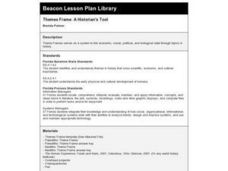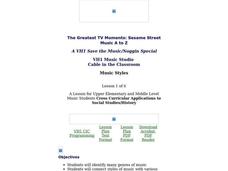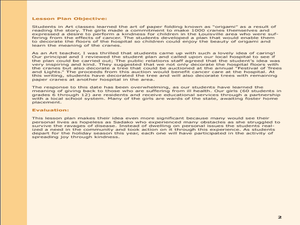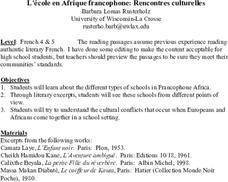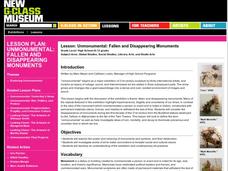Curated OER
Ancient Sun Models of the World
Young scholars explain that many different cultures across the world developed their own reasoning for the weather around them. They explore the different cultural beliefs of the sun's cycle and to create their own story of the sun's...
Curated OER
Themes Frame: A Historian's Tool
High schoolers research the scientific, economic, and cultural themes that connect Paleolithic and Neolithic inhabitants. They complete Paleolithic and Neolithic Theme Frames, comparing/contrasting the two cultures in an essay or Venn...
Curated OER
Doorways/Printmaking
Students are introduced to the techniques used in printmaking along with the relief method and tessellation relationships to art. In groups, they examine a variety of architecture used throughout the Islamic culture. To end the lesson...
Curated OER
Headlines of the Past
Young scholars study the lives of four Native cultures. They examine the people that inhabited Wisconsin over the last 12,000 years. They create a newspaper and imagine themselves as a reporter living during this time period and sharing...
Curated OER
Using Southeast Asian Folktales to Teach Reading and Writing
Students use maps to locate the countries of Thailand, Vietnam and Cambodia. In groups, they compare and contrast the three countries in regard to their culture, morals and values. They read various examples of folktales and write their...
Curated OER
Inclusion/Exclusion
Students explore the time and culture of the Inuit people. They view the play Ice Wolf and discuss its importance. Students discuss the feeling of being included and excluded. They write brief stories about a real experience or...
Curated OER
Music Styles
Students identify many genres of music and connect styles of music with various cultures. They watch "The Greatest TV Moments: Sesame Street Music A to Z" and list music styles: folk, jazz, rock, etc.
Curated OER
Surprise at Pearl Harbor
Students review the concept of courage and relate it to their daily life. As a class, they are introduced to the events of December 7, 1941 at Pearl Harbor. Using a map, they locate Hawai'i and label the islands. They use the internet to...
Curated OER
Birthday Party
Young scholars help plan a party for Q-Bear and think about some of the different ways people celebrate their birthdays. They then demonstrate knowledge and understanding of customs and traditions associated with participation in...
Curated OER
Hidden Messages: The Growth of Product Placement
Pupils identify product placements they see in TV programs and movies. They build awareness of the pervasiveness of advertising in their culture. They develop critical skills necessary to think independently in a media saturated consumer...
Curated OER
Murals With a Message
Learners recognize historical and cultural influences in art and appreciate art as a vehicle for public expression of ideas. They develop group skills, working together to produce a single mural or several related murals.
Curated OER
Archaeology is ...
Students demonstrate the importance of context for learning about ancient people. They assess the importance of preservation of cultural resources. They exchange papers with a student in class. The students with the paper are responsible...
Curated OER
Literature and the "Age of Anxiety" (1920s and 1930s).
Students examine historical events of the 1920s, World War II and the Cold War. They discover how literature reflects the economic, political, social, religious and historical concerns of a culture. Students compare literature writings...
Curated OER
Origami Paper Cranes
Students complete cross-curricular activities to study the culture and humanity in Japan. Students read the book Sadako and the 1000 Paper Cranes and complete social studies and art lessons related to the book as well as develop an...
Curated OER
Poetry Describing Ordinary Life
Pupils examine the cultural and historical context which a poem is written in or describes. In this poetry lesson, students listen to an online recording of Philip Larkin reading "The Whitsun Wedding." Pupils explore how the poem...
Curated OER
Create Your Own Country!
Students create their own countries. In this geography skills lesson, students establish governments, cultural backgrounds, atlas/geography components, national anthems, and national symbols for a country they create.
Curated OER
L'école En Afrique Francophone: Rencontres Culturelles
Students utilize the French language to explore the different types of schools in Francophone, Africa. French literary excerpts provide a look into the cultural conflicts that occur when Europeans and Africans come together in a school...
Smithsonian Institution
Dia de los Muertos: Celebrating and Remembering
Help scholars understand the history, geography, traditions, and art of Dia de los Muertos, the Day of the Dead. Find background information for your reference as well as a detailed cross-curricular lesson plan. Learners compare...
New Museum of Contemporary Art
Lesson: Unmonumental: Fallen and Disappearing Monuments
Due to vandalism, war, and urban decay, many of the world's great monuments have fallen to ruin. Here is an interesting lesson that increases understanding of the dichotomy between what are intended as lasting tributes, and their...
San Francisco Symphony
Mr. Lincoln Through the Eyes of Aaron Copland
Use Aaron Copland's symphonic piece, "Lincoln Portrait" to engage learners in a cross-curricular experience. They'll listen to the piece, watch a video, read the Gettysburg Address, and write a series of fact or opinion sentences. An...
EduGAINs
Consumerism, Me and the Natural Environment— Canadian and World Studies
Just as no man is an island, no country is totally independent of other countries. To understand the impact of individual consumer decisions on the global natural environment, class groups consider how the stuff they...
Curated OER
Crossing Time Zones
Students explore the concept of differing time zones. Students refer to maps to identify the time zones in particular regions. They role play phone calls from different time zones. This lesson is intended for students acquiring English.
Curated OER
Diminutivos
There are several reasons why Spanish speakers use the diminutive form. Not only is it used to indicate size, but it can also indicate affection. This plan, while not incredibly detailed, does provide some great questions for...
Curated OER
Future Actions
How do you conjugate a reflexive verb? This plan suggests reading a children's book to your intermediate Spanish speakers. Follow the reading with a PowerPoint slide show that presents reflexive verbs, a sentence using the verb, and a...

